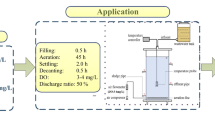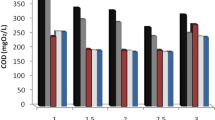Abstract
A laboratory-scale anoxic–oxic sequential reactor system was seeded with acclimatized mixed microbial consortium for the treatment of common effluent treatment plant (CETP) wastewater having 7000–7400 mg L−1 of COD and 3000–3400 mg L−1 of BOD. Initially, CETP wastewater was treated under anoxic reactor at 5000 mg L−1 of MLSS concentrations, 5.26 ± 0.27 kg COD m−3 day−1 of organic loading rate (OLR) and 36 h of hydraulic retention time (HRT). Further, the effluent of anoxic reactor was treated in oxic reactor with an OLR of 6.6 ± 0.31 kg COD m−3 day−1 and 18 h HRT. Maximum color and COD removal were found to be 72 and 85 % at total HRT of 2.25 days under anoxic–oxic sequential reactor at 37 °C and pH 7.0. The UV–VIS, FTIR, NMR and GCMS studies showed that majority of peaks observed in untreated wastewater were either shifted or disappeared after sequential treatment. Phytotoxicity study with the seeds of Vigna radiata and Triticum aestivum showed more sensitivity toward the CETP wastewater, while the products obtained after sequential treatment does not have any inhibitory effects. The results demonstrated that the anoxic–oxic reactor fed with bacterial consortium VN11 could bring about efficient bioremediation of industrial wastewaters.




Similar content being viewed by others
References
Vyas, M., Modhera, B., & Sharma, A. (2015). BOD approximation for common effluent treatment plant using ANN. Asian Journal of Water, Environment and Pollution, 12, 81–89.
Guieysse, B., & Norvill, Z. N. (2014). Sequential chemical–biological processes for the treatment of industrial wastewaters: review of recent progresses and critical assessment. Journal of hazardous materials, 267, 142–152.
Moosvi, S., & Madamwar, D. (2007). An integrated process for the treatment of CETP wastewater using coagulation, anaerobic and aerobic process. Bioresource technology, 98, 3384–3392.
Yao, Y., Lu, Z., Zhu, F., Min, H., & Bian, C. (2013). Successful bioaugmentation of an activated sludge reactor with Rhodococcus sp. YYL for efficient tetrahydrofuran degradation. Journal of hazardous materials, 261, 550–558.
Wang, D., Xu, Q., Yang, W., Chen, H., Li, X., Liao, D., & Zeng, G. (2014). A new configuration of sequencing batch reactor operated as a modified aerobic/extended-idle regime for simultaneously saving reactor volume and enhancing biological phosphorus removal. Biochemical Engineering Journal, 87, 15–24.
Sandhya, S., Padmavathy, S., Swaminathan, K., Subrahmanyam, Y. V., & Kaul, S. N. (2005). Microaerophilic–aerobic sequential batch reactor for treatment of azo dyes containing simulated wastewater. Process Biochemistry, 40, 885–890.
Xu, S., Wu, D., & Hu, Z. (2014). Impact of hydraulic retention time on organic and nutrient removal in a membrane coupled sequencing batch reactor. Water research, 55, 12–20.
Martin-Hernandez, M., Suarez-Ojeda, M. E., & Carrera, J. (2012). Bioaugmentation for treating transient or continuous p-nitrophenol shock loads in an aerobic sequencing batch reactor. Bioresource technology, 123, 150–156.
Al–Amrani, W. A., Lim, P. E., Seng, C. E., & Ngah, W. S. W. (2014). Factors affecting bio–decolourization of azo dyes and COD removal in anoxic–aerobic REACT operated sequencing batch reactor. Journal of the Taiwan Institute of Chemical Engineers, 45, 609–616.
Acharya, B. K., Pathak, H., Mohana, S., Shouche, Y., Singh, V., & Madamwar, D. (2011). Kinetic modelling and microbial community assessment of anaerobic biphasic fixed film bioreactor treating distillery spent wash. Water research, 45, 4248–4259.
APHA. (2012). Standard methods for the examination of water and wastewater. Washington DC: American Public Health Association.
Balapure, K., Bhatt, N., & Madamwar, D. (2015). Mineralization of reactive azo dyes present in simulated textile waste water using down flow microaerophilic fixed film bioreactor. Bioresource technology, 175, 1–7.
Meng, X., Liu, G., Zhou, J., Fu, Q. S., & Wang, G. (2012). Azo dye decolorization by Shewanella aquimarina under saline conditions. Bioresource technology, 114, 95–101.
Telke, A. A., Kim, S. W., & Govindwar, S. P. (2012). Significant reduction in toxicity, BOD, and COD of textile dyes and textile industry effluent by a novel bacterium Pseudomonas sp. LBC1. Folia microbiologica, 57, 115–122.
Hatvani, N., & Mecs, I. (2001). Production of laccase and manganese peroxidase by Lentinus edodes on malt-containing by-product of the brewing process. Process Biochemistry, 37, 491–496.
Lowry, O. H., Rosebrough, N. J., Farr, A. L., & Randall, R. J. (1951). Protein measurement with the Folin phenol reagent. Journal of biological chemistry, 193, 265–275.
Rasool, K., Ahn, D. H., & Lee, D. S. (2014). Simultaneous organic carbon and nitrogen removal in an anoxic–oxic activated sludge system under various operating conditions. Bioresource technology, 162, 373–378.
Gray, N. F. (2004). Biology of wastewater treatment (2nd ed.). London: Imperial College Press.
Tay, J. H., Pan, S., He, Y., & Tay, S. T. L. (2004). Effect of organic loading rate on aerobic granulation. I: Reactor performance. Journal of environmental engineering, 130, 1094–1101.
Su, Y. M., Makinia, J., & Pagilla, K. R. (2008). Estimation of autotrophic maximum specific growth rate constant—experience from the long-term operation of a laboratory-scale sequencing batch reactor system. Water Environment Research, 80, 355–366.
Karkare, M. V., & Murthy, Z. V. P. (2012). Kinetic studies on agrochemicals wastewater treatment by aerobic activated sludge process at high MLSS and high speed agitation. Journal of Industrial and Engineering Chemistry, 18, 1301–1307.
Kumar, V., Dhall, P., Naithani, S., Kumar, A., & Kumar, R. (2014). Biological approach for the treatment of pulp and paper industry effluent in sequence batch reactor. Journal of Bioremediation Biodegradation, 5, 2.
Barr, T. A., Taylor, J. M., & Duff, S. J. (1996). Effect of HRT, SRT and temperature on the performance of activated sludge reactors treating bleached kraft mill effluent. Water Research, 30, 799–810.
Han, H., & Qiao, J. (2013). Hierarchical neural network modeling approach to predict sludge volume index of wastewater treatment process. Control Systems Technology, IEEE Transactions on, 21, 2423–2431.
Dafale, N., Wate, S., Meshram, S., & Nandy, T. (2008). Kinetic study approach of remazol black–B use for the development of two–stage anoxic–oxic reactor for decolourization/biodegradation of azo dyes by activated bacterial consortium. Journal of hazardous materials, 159, 319–328.
Holenda, B., Domokos, E., Redey, A., & Fazakas, J. (2008). Dissolved oxygen control of the activated sludge wastewater treatment process using model predictive control. Computers & Chemical Engineering, 32, 1270–1278.
Yadav, T. C., Khardenavis, A. A., & Kapley, A. (2014). Shifts in microbial community in response to dissolved oxygen levels in activated sludge. Bioresource technology, 165, 257–264.
Pittoors, E., Guo, Y., & Van Hulle, W. H. S. (2014). Modeling dissolved oxygen concentration for optimizing aeration systems and reducing oxygen consumption in activated sludge processes: a review. Chemical Engineering Communications, 201, 983–1002.
McMullan, G., Meehan, C., Conneely, A., Kirby, N., Robinson, T., Nigam, P., & Smyth, W. (2001). Microbial decolourisation and degradation of textile dyes. Applied Microbiology and Biotechnology, 56, 81–87.
Caulet, P., Bujon, B., Philippe, J. P., Lefevre, F., & Audic, J. M. (1998). Upgrading of wastewater treatment plants for nitrogen removal: industrial application of an automated aeration management based on ORP evolution analysis. Water science and technology, 37, 41–47.
Chary, K. P., Ram, S. R., & Iyengar, D. S. (2000). Reductions using ZrCl4/NaBH4: a novel and efficient conversion of aromatic, aliphatic nitro compounds to primary amines. Synlett, 2000, 0683–0685.
Myers, M., Myers, L., & Okey, R. (2006). The use of oxidation–reduction potential as a means of controlling effluent ammonia concentration in an extended aeration activated sludge system. Proceedings of the Water Environment Federation, 2006, 5901–5926.
Sperandio, M., & Queninnec, I. (2004). Online estimation of wastewater nitrifiable nitrogen, nitrification, and denitrification rates using ORP and DO dynamics. Water Science and Technology, 40, 31–38.
Habertmeyer, P., & Sanchez, A. (2005). Optimization of the intermittent aeration in a full–scale wastewater treatment biological reactor for nitrogen removal. Water Environment Research, 77, 229–233.
Pandey, A., Singh, P., & Iyengar, L. (2007). Bacterial decolourization and degradation of azo dyes. International Biodeterioration & Biodegradation, 59, 73–84.
Carvalho, M. C., Pereira, C., Goncalves, I. C., Pinheiro, H. M., Santos, A. R., Lopes, A., & Ferra, M. I. (2008). Assessment of the biodegradability of a monosulfonated azo dye and aromatic amines. International Biodeterioration & Biodegradation, 62, 96–103.
Khehra, M. S., Saini, H. S., Sharma, D. K., Chadha, B. S., & Chimni, S. S. (2005). Decolourization of various azo dyes by bacterial consortium. Dyes and Pigments, 67, 55–61.
Shailaja, S., Ramakrishna, M., Mohan, S. V., & Sarma, P. N. (2007). Biodegradation of di-n-butyl phthalate (DnBP) in bioaugmented bioslurry phase reactor. Bioresource technology, 98, 1561–1566.
Mahmood, S., Khalid, A., Arshad, M., Mahmood, T., & Crowley, D. E. (2015). Detoxification of azo dyes by bacterial oxidoreductase enzymes. Critical reviews in biotechnology, 0, 1–13.
Acknowledgments
Authors gratefully acknowledge the Department of Biotechnology (DBT), New Delhi for the research grant (grant No. BT/PR-11724/BCE/08/719/2008) and the Government of India for the financial support during the study. The authors are thankful to Gujarat State Biotechnology Mission (GSBTM), Gandhinagar, Gujarat, India for providing facilities for DNA sequencing of pure cultures.
Author information
Authors and Affiliations
Corresponding author
Ethics declarations
Conflict of Interest
The authors declare that they have no conflict of interest. Authors also confirmed that all funding agencies that supported this work are acknowledged in this manuscript according to their guidelines.
The authors declare that there is no ethical issue associated with this manuscript. No human participants or animal have been used in this manuscript.
Electronic Supplementary Material
Below is the link to the electronic supplementary material.
ESM 1
Fig 1 Effect of (a) F/M ratio on sludge volume index (SVI) (b) pH of the substrate entering to the oxic reactor and (c) wastewater DO level for the treatment of wastewater by consortium VN11. (DOC 104 kb)
ESM 2
Table 1 Evaluation of degradation at sequential anoxic-oxic bioreactor. (DOC 27 kb)
ESM 3
Fig. 2 UV-VIS spectrum of wastewater before and after treatment by sequential anoxic-oxic bioreactor with the help of consortium VN11. (DOC 43 kb)
ESM 4
Fig. 3 FTIR spectrum of wastewater (a) before and (b) after treatment by sequential anoxic-oxic bioreactor with the help of consortium VN11. (DOC 284 kb)
ESM 5
Fig. 4 NMR spectrum of wastewater (a) before and (b) after treatment by sequential anoxic-oxic bioreactor with the help of consortium VN11. (DOC 117 kb)
ESM 6
Table 2 List of intermediates identified on the basis of GC-MS (DOC 287 kb)
ESM 7
Fig. 5 Scanning Electron Microscopic analysis of sludge of wastewater after anoxic stage treatment (a) 3500× magnification (b) 10000× magnification. (DOC 1558 kb)
ESM 8
Fig. 6 Scanning Electron Microscopic analysis of sludge from oxic reactor during wastewater treatment with the sequential anoxic-oxic bioreactor by consortium VN11 at different magnification (a) 10000× magnification and (b) 15000× magnification. (DOC 1841 kb)
Rights and permissions
About this article
Cite this article
Chattaraj, S., Purohit, H.J., Sharma, A. et al. Treatment of Common Effluent Treatment Plant Wastewater in a Sequential Anoxic–Oxic Batch Reactor by Developed Bacterial Consortium VN11. Appl Biochem Biotechnol 179, 514–529 (2016). https://doi.org/10.1007/s12010-016-2010-2
Received:
Accepted:
Published:
Issue Date:
DOI: https://doi.org/10.1007/s12010-016-2010-2




